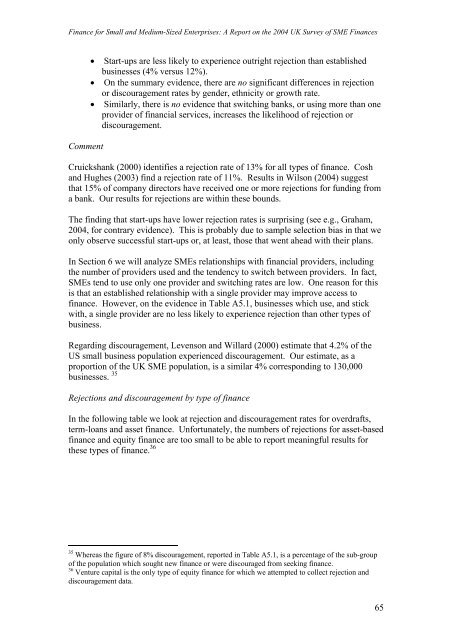Finance for Small and Medium-Sized Enterprises - DTI Home Page
Finance for Small and Medium-Sized Enterprises - DTI Home Page
Finance for Small and Medium-Sized Enterprises - DTI Home Page
You also want an ePaper? Increase the reach of your titles
YUMPU automatically turns print PDFs into web optimized ePapers that Google loves.
<strong>Finance</strong> <strong>for</strong> <strong>Small</strong> <strong>and</strong> <strong>Medium</strong>-<strong>Sized</strong> <strong>Enterprises</strong>: A Report on the 2004 UK Survey of SME <strong>Finance</strong>s<br />
Comment<br />
• Start-ups are less likely to experience outright rejection than established<br />
businesses (4% versus 12%).<br />
• On the summary evidence, there are no significant differences in rejection<br />
or discouragement<br />
rates by gender, ethnicity or growth rate.<br />
• Similarly, there is no evidence that switching banks, or using more than one<br />
provider of financial services, increases the likelihood of rejection or<br />
discouragement.<br />
Cruickshank<br />
(2000) identifies a rejection rate of 13% <strong>for</strong> all types of finance. Cosh<br />
<strong>and</strong> Hughes (2003) find a rejection rate of 11%. Results in Wilson (2004) suggest<br />
that<br />
15% of company directors have received one or more rejections <strong>for</strong> funding from<br />
a bank. Our results <strong>for</strong> rejections are within these bounds.<br />
The finding that start-ups have lower rejection rates is surprising<br />
(see e.g., Graham,<br />
2004,<br />
<strong>for</strong> contrary evidence). This is probably due to sample selection bias in that we<br />
only observe successful start-ups<br />
or, at least, those that went ahead with their plans.<br />
In Section 6 we will analyze SMEs relationships<br />
with financial providers, including<br />
the number of providers used <strong>and</strong> the tendency to switch between providers.<br />
In fact,<br />
SM Es tend to use only one provider <strong>and</strong> switching rates are low. One<br />
reason <strong>for</strong> this<br />
is that an established relationship with a single provider may improve access to<br />
finance. However, on the evidence in Table A5.1, businesses which use, <strong>and</strong> stick<br />
with, a single provider are no less likely to experience rejection than other types of<br />
business.<br />
Regarding discouragement, Levenson <strong>and</strong> Willard (2000) estimate that<br />
4.2% of the<br />
US<br />
small business population experienced discouragement. Our estimate,<br />
as a<br />
proportion of the UK SME population, is a similar 4% corresponding to 130,000<br />
35<br />
businesses.<br />
Rejections <strong>and</strong> discouragement by type of finance<br />
In the following table we look at rejection <strong>and</strong> discouragement rates <strong>for</strong> overdrafts,<br />
term-loans <strong>and</strong> asset finance. Un<strong>for</strong>tunately, the numbers of rejections <strong>for</strong> asset-based<br />
finance <strong>and</strong> equity finance are too small to be able to report meaningful results <strong>for</strong><br />
these types of finance. 36<br />
35 Whereas the figure of 8% discouragement, reported in Table A5.1, is a percentage of the sub-group<br />
of the population which sought new finance or were discouraged from seeking finance.<br />
36 Venture capital is the only type of equity finance <strong>for</strong> which we attempted to collect rejection <strong>and</strong><br />
discouragement data.<br />
65















![Joint Report on Social Protection and Social Inclusion [2005]](https://img.yumpu.com/19580638/1/190x132/joint-report-on-social-protection-and-social-inclusion-2005.jpg?quality=85)
